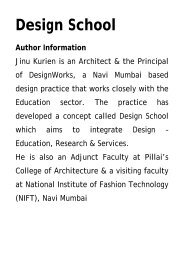Ameena Batada - Designing for Children
Ameena Batada - Designing for Children
Ameena Batada - Designing for Children
Create successful ePaper yourself
Turn your PDF publications into a flip-book with our unique Google optimized e-Paper software.
the people, animals, and things on the pond. As children tell these stories, they build<br />
sentences and develop their narrative skills, both important parts of language<br />
development. The kit includes a teacher’s book, which provides guidance on how to use<br />
the story pond and a sample story.<br />
Though relatively simple in design, the story pond is extremely powerful in activating<br />
children’s imagination and playfulness. In the creations of stories, children construct roles<br />
and scenarios similar to pretend play. The addition of telling the story out loud builds<br />
children’s sentence <strong>for</strong>mation and their narrative skills, which are important pre-literacy<br />
skills. While using the story pond, children also develop gross motor and balancing skills.<br />
To date, the story pond kit is the most popular with balwadi teachers. Another favorite of<br />
teachers, which provides an exciting interactive environment, is the bioscope.<br />
Figure 2. Story Pond Kit incorporates play and imagination to build literacy<br />
2.2.2 Bioscope<br />
The GGSS bioscope revives a traditional <strong>for</strong>m of Indian entertainment to rein<strong>for</strong>ce GGSS<br />
messages interactively. The bioscope consists of a decorated box with large peepholes<br />
inserted around the outside. Inside, there is a scroll featuring still images from the GGSS<br />
television show, which is wound by a teacher or caregiver from the top of the bioscope.<br />
Balwadi’s receive a tape and tape recorder so they can play music while turning the scroll<br />
and children view the material from outside. The bioscope invites children to see the<br />
television characters and their classroom materials in a different way and they are able to<br />
talk about what they have observed in meaningful ways after viewing.<br />
Bioscopes are available in 500 balwadis in the six intervention cities. Caregivers report<br />
that attendance is highest on the days when children know that the bioscope will be used<br />
at the centre.




